2. Customizing Your Galaxy Note 3

In this chapter, you find out how to customize your Galaxy Note 3 to suit your needs and lifestyle. Topics include the following:
→ Using wallpapers and live wallpapers
→ Replacing the keyboard
→ Adjusting sound and display settings
→ Setting region and language
Your Galaxy Note 3 arrives preconfigured to appeal to most buyers; however, you might want to change the way some of the features work, or even personalize it to fit your mood or lifestyle. Luckily your Galaxy Note 3 is customizable.
Changing Your Wallpaper
Your Galaxy Note 3 comes preloaded with a cool wallpaper. You can install other wallpapers, use live wallpapers that animate, and even use pictures in the Gallery application as your wallpaper.
1. Touch and hold in an open area on the Home screen.
2. Touch Set Wallpaper.

3. Select where you want to change the wallpaper.

4. Touch the type of wallpaper you want to use. Use the steps in one of the following three sections to select your wallpaper.
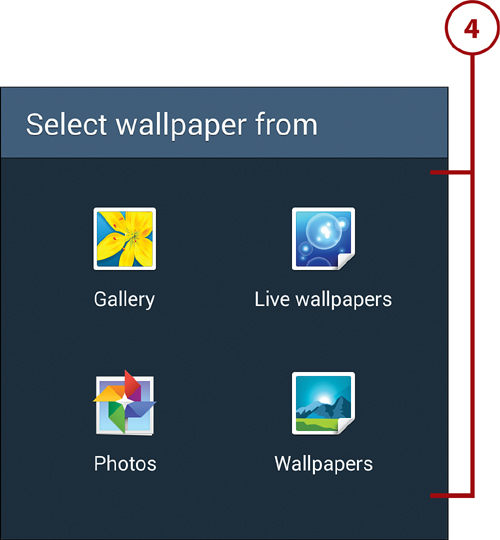
1. Select the photo you want to use as your wallpaper.
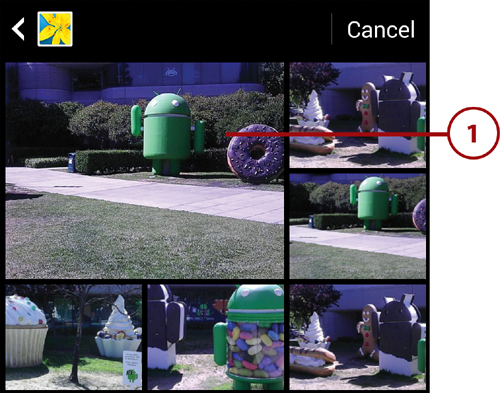
2. Touch Crop Picture.
3. Touch Just Once.

4. Move the crop box to the part of the photo you want to use.
5. Adjust the size of the crop box to include the part of the photo you want.
6. Zoom in and out of the picture using the pinch gesture.
7. Touch Done to use the cropped portion of the photo as your wallpaper.

Live Wallpaper
Live wallpaper is wallpaper with some intelligence behind it. It can be a cool animation or even an animation that keys off things such as the music you are playing on your Galaxy Note 3, or it can be something simple such as the time. There are some very cool live wallpapers in Google Play that you can install and use.
1. Touch the live wallpaper you want to use.
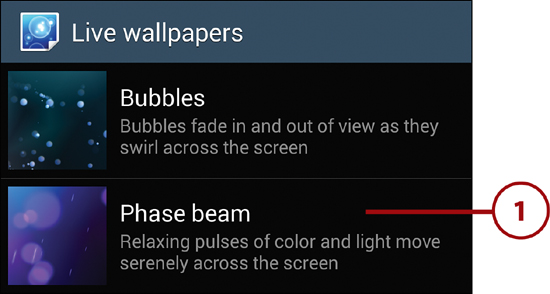
2. Touch Set Wallpaper to use the live wallpaper.

Finding More Wallpaper
You can find wallpaper or live wallpaper in the Google Play Store. Open the Google Play Store app and search for “wallpaper” or “live wallpaper.” Read more on how to use the Google Play Store in Chapter 11, “Working with Android Apps.”
1. Scroll left and right to see all of the wallpapers.
2. Touch Set Wallpaper to use the wallpaper.

Wallpaper from Photos
You can make wallpaper from any picture that is stored in your Google+ Photos service.
1. Select the photo you want to use as your wallpaper.

2. Move the crop box to the part of the photo you want to use.
3. Adjust the size of the crop box to include the part of the photo you want.
4. Touch Save to use the cropped portion of the photo as your wallpaper.

Changing Your Keyboard
If you find it hard to type on the standard Galaxy Note 3 keyboard, or you just want to make it look better, you can install replacement keyboards. You can download free or purchase replacement keyboards from the Google Play Store. Make sure you install a keyboard before following these steps.
1. Pull down the notification bar and touch the Settings icon.

2. Touch Language and Input on the Controls tab.

3. Check the box next to a keyboard you have previously installed from the Google Play Store (in this example, we used SwiftKey Trial) to make that keyboard available for use.
4. Touch OK to change the input method.
Doing Your Research
When you choose a different keyboard in step 3, the Galaxy Note 3 gives you a warning telling you that nonstandard keyboards have the potential for capturing everything you type. Do your research on any keyboards before you download and install them.
5. Touch Default to change the default keyboard to the one you have just enabled.


6. Touch the name of your new keyboard to select it to be the default.

What Can You Do with Your New Keyboard?
Keyboards you buy in the Google Play Store can do many things. They can change the key layout, change the color and style of the keys, offer different methods of text input, and even enable you to use an old T9 predictive input keyboard that you might have become used to when using an old “dumb phone” that only had a numeric keypad.
7. Touch the Settings icon for a keyboard to make changes, including customizing it.
8. Touch to save your changes.

Adding Widgets to Your Home Screens
Some applications that you install come with widgets that you can place on your Home screens. These widgets normally display real-time information, such as stocks, weather, time, and Facebook feeds. Your Galaxy Note 3 also comes preinstalled with some widgets. Here is how to add and manage widgets.
Add a Widget
Your Galaxy Note 3 should come preinstalled with some widgets, but you might also have some extra ones that have been added when you installed other applications. Here is how to add those widgets to your Home screens.
1. Touch and hold an open area on the Home screen.
2. Touch Apps and Widgets.
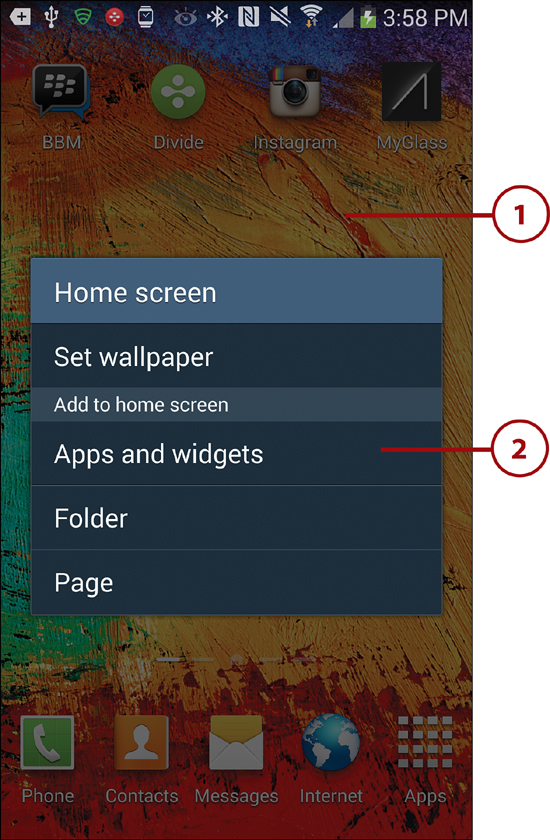
4. Touch and hold a widget to move it to the Home screen. Keep holding the widget as you move to step 5. This example uses the Calendar (Month).

5. Position the widget where you want it on the Home screen.
6. Drag the widget between sections of the Home screen.
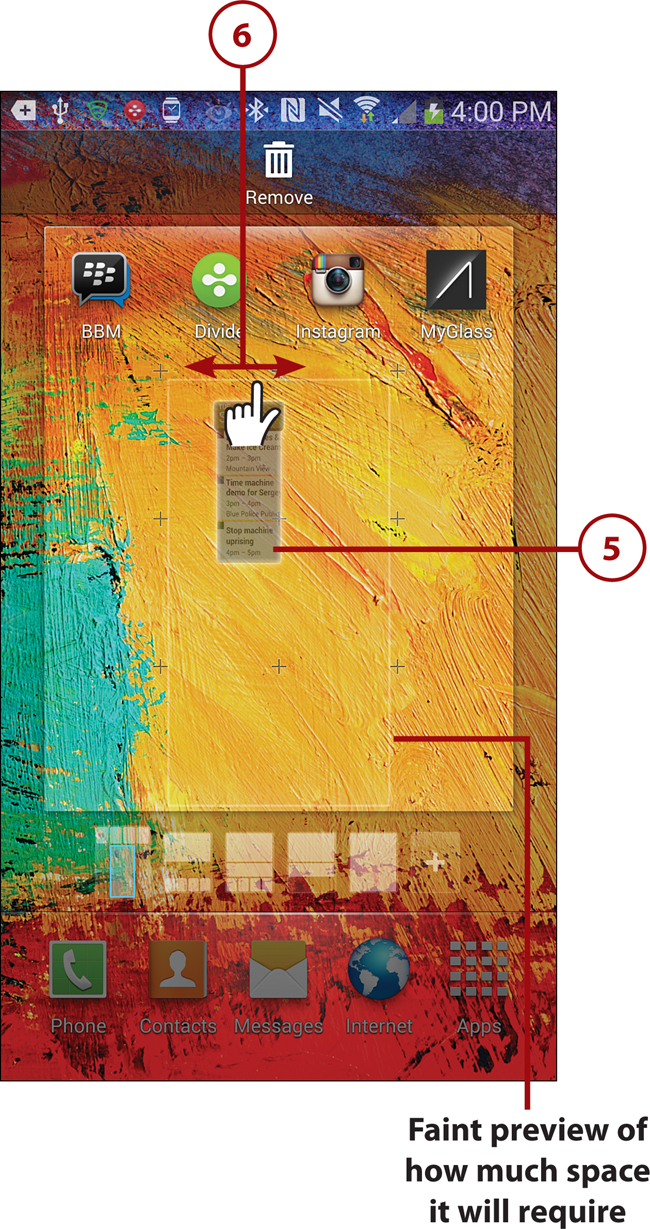
7. Release your finger to place the widget. Some widgets ask you a few questions after they are positioned.

How Many Widgets Can I Fit?
Each part of the Home screen is divided into four blocks across and four blocks down. In the figure for steps 3 and 4, notice that each one shows its size in blocks across and down (such as 2×3). From that, you can judge if a widget is going to fit on the screen you want it to be on, but it also helps you position it in step 4.
Resizing Widgets
Some (not all) widgets can be resized. To resize a widget, touch and hold the widget until you see an outline and then release it. If the widget can be resized, you see the resizing borders. Drag them to resize the widget. Touch anywhere on the screen to stop resizing.
1. Touch and hold the widget until you see a blue shadow, but continue to hold the widget.

2. Drag the widget to the word Remove to remove it.
3. Drag the widget around the screen or drag it between sections of the Home screen to reposition it.
4. Release the widget.
Setting the Language
If you move to another country or want to change the language used by your Galaxy Note 3, you can do so with a few touches.
1. Pull down the Notification bar and touch the Settings icon.

2. Touch Language and Input on the Controls tab.

3. Touch Language.

4. Touch the language you want to switch to.

What Obeys the Language Setting?
When you switch your Galaxy Note 3 to use a different language, you immediately notice that all standard applications and the Galaxy Note 3 menus switch to the new language. Even some third-party applications honor the language switch. However, many third-party applications ignore the language setting on the Galaxy Note 3. So you might open a third-party application and find that all of its menus are still in English.
Changing Accessibility Settings
Your Galaxy Note 3 includes built-in settings to assist people who might otherwise have difficulty using some features of the device. The Galaxy Note 3 has the ability to provide alternative feedback, such as vibration and sound. It can even read menu items aloud to you.
1. Pull down the Notification bar and touch the Settings icon.

2. Touch Accessibility on the Device tab.

3. Touch to enable automatic screen rotation. When disabled, the screen does not rotate between Portrait and Landscape modes.
4. Touch to set how many minutes of inactivity your Galaxy Note 3 waits before timing out the screen.
5. Touch to enable or disable the feature where your Note 3 speaks your passwords as you type them.
6. Touch to choose whether to use the Home key to answer calls or answer calls with a voice command. You can also designate to use the power key to end calls.
7. Touch to enable or disable the feature where you can simply touch the icons on the Lock or Home screen instead of having to drag them.
8. Touch to enable or disable the feature where you can press and hold the power key to jump straight to this Accessibility settings screen.
9. Touch to export your accessibility settings as a file or update them from a file. You can also share your exported accessibility file with others.
10. Scroll down for more settings.

11. Touch to enable or disable TalkBack. When enabled, TalkBack speaks everything, including menus.
12. Touch to set the font size used on your Galaxy Note 3. You can choose sizes ranging from tiny to huge.
13. Touch to enable or disable magnification gestures, which include the ability to magnify any screen by double-tapping it. When a screen is magnified, you can pan around it.
14. Touch to enable or disable negative colors where all colors displayed on your Galaxy Note 3 are reversed.
15. Touch to enable the Color Adjustment Wizard that helps you adjust the screen colors if you have difficulty seeing it.
16. Touch to enable or disable the notification reminder that beeps to remind you that you have unread notifications (such as a new email notification).
17. Touch to enable or disable the accessibility shortcut. When it’s enabled, you can access accessibility features by doing certain gestures.
18. Touch to change the settings for the text-to-speech service provided by Samsung.
19. Scroll down for more settings.
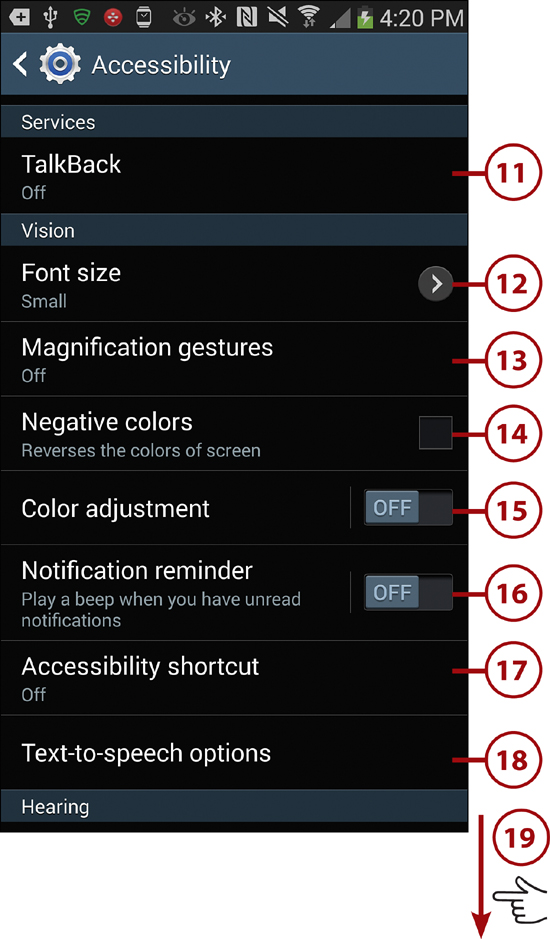
20. Touch to adjust the balance of audio played when wearing earphones.
21. Touch to use mono audio when wearing one earphone.
22. Touch to turn off all sounds.
23. Touch to enable or disable improving the sound quality if you use a hearing aid.
24. Touch to enable or disable making your Note 3 light up the camera flash when you have a new notification.
25. Touch to enable or disable a special assistant menu that stays on the screen at all times.
26. Touch to change how long you have to hold when you perform a touch-and-hold on the screen.
27. Scroll down for more settings.
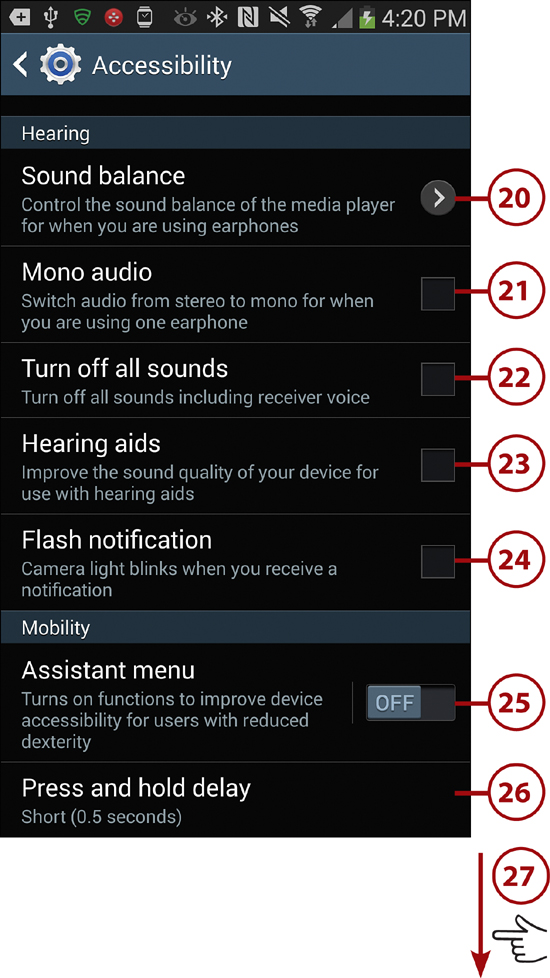
28. Touch to enable or disable interaction control, which includes blocking areas of the screen so they do not respond to touch.
29. Touch to save your changes.
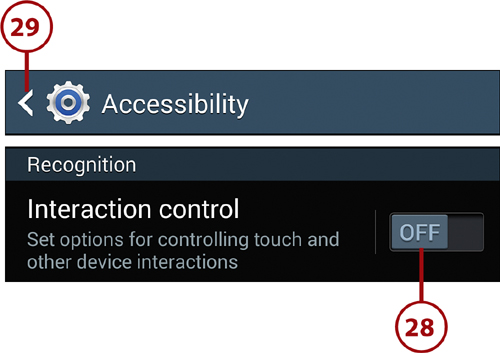
More About Text-to-Speech
By default, your Galaxy Note 3 uses the Samsung Text-to-Speech service with an option to use the Samsung service to speak any text that you need to read. You can install other text-to-speech software by searching for them in the Google Play Store. After you’ve installed the software, you’ll have multiple choices in step 18.
Adjusting Sound Settings
You can change the volume for games, ringtones, and alarms, change the default ringtone and notification sound, plus control what system sounds are used.
1. Pull down the Notification bar and touch the Settings icon.

2. Touch Sound on the Device tab.

3. Touch to change the volume for games and media, such as videos and music, ringtones and notifications, and alarms.
4. Touch to choose the intensity of vibrations for incoming calls, notifications, and haptic feedback.
5. Touch to choose the default notification ringtone or add new ones.
6. Touch to choose the vibration pattern used for notifications or create your own.
7. Touch to choose the sound that plays for notifications.
8. Touch to enable or disable playing a sound and vibration when being notified. This option is only available when you have your Galaxy Note 3 in Sound mode.
9. Touch to enable or disable playing touch-tone sounds when typing numbers on the phone keypad.
10. Touch to enable or disable the touch sounds that play when you touch something on the screen or a menu.
11. Scroll down for more settings.

12. Touch to enable or disable the screen lock sound that plays when your Galaxy Note 3 locks the screen after the inactivity timeout.
13. Touch to enable or disable Haptic feedback, which is a vibration that indicates that you have successfully touched the Menu and Back keys.
14. Touch to choose the sound that plays when you remove or put back the S Pen. Learn more about the S Pen in the Prologue.
15. Touch to enable or disable a sound that plays when you tap keys.
16. Touch to enable or disable a vibration that is triggered when you tap keys.
17. Touch to select Stereo or Surround sound when media is played via the HDMI cable.
18. Touch to adapt the sound output for calls and music, by taking a quick audio ear exam.
19. Touch to save your changes and return to the previous screen.


Creating Your Own Vibration Patterns
In step 6, you can choose the vibration pattern to be used when you are notified, but you can also create your own. Touch Create. On the next screen, touch in the area where it reads Tap to Create, and then tap out your vibration pattern on the screen using short taps for short vibrations and long taps for longer vibrations. The example in the figure uses Morse Code for SOS. You can literally create any vibration pattern you want.
Modifying Display Settings
You can change many display settings including the screen brightness or set it to automatic, change the screen mode, change how long to wait before your Galaxy Note 3 goes to sleep, change the size of the font used, and change whether to use the Pulse notification light.
1. Pull down the Notification bar and touch the Settings icon.

2. Touch Display under the Device tab.

3. Touch to change the screen brightness manually or set it to automatic. When on automatic, your Galaxy Note 3 uses the built-in light sensor to adjust the brightness based on the light levels in the room.
4. Touch to choose how many minutes of inactivity must pass before your Galaxy Note 3 puts the screen to sleep.
5. Touch to set how long the backlight behind the Menu and Back touch keys remain illuminated after you either touch the screen or touch one of the Touch keys.
6. Touch to choose the Screen mode, which is how the screen represents colors. You can choose Dynamic, Standard, Professional Photo, Movie, or leave it set to Adapt Display, which means your Note 3 chooses the best settings based on usage.

If you leave your screen mode set to Adapt Display, you should know that your Note 3 adjusts the color range, saturation, and sharpness of the screen for the Gallery, Camera, Internet Web Browser, Samsung Video, Samsung WatchON, and Google Play Books apps only. All other system apps and apps that you install are not optimized. With this in mind, you might prefer to manually select an appropriate screen mode in step 6.
7. Touch to set Reading mode on or off. Reading mode adjusts the screen so its easier on your eyes, typically for reading books or working with apps that require you to look at the screen for a long time.
8. Touch to add or remove apps that, when run, automatically start Reading mode.
9. Touch to enable or disable automatically adjusting the tone of the screen based on the kinds of images being shown.
10. Touch to enable or disable Daydream mode. Daydream mode is essentially a screensaver.
11. Touch to select which screen saver to use, and manage its settings. You can also choose when the Daydream mode activates.
12. Touch to enable or disable a feature that uses the front-facing camera to determine the orientation of the screen based on the orientation of your face.
13. Touch to enable or disable displaying the battery level as a percentage as well as showing the level graphically.
14. Scroll down for more settings.

In steps 10 and 11 you can enable and manage the Daydream mode, which is essentially a screensaver as we remember it from desktop computers. For many years now, screensavers have not been needed because we no longer use Cathode Ray Tube (CRT) monitors and screens. In the days when we used CRTs, if an image remained in one spot for a long time, it would be burned into the front of the screen. Having a screensaver on a CRT monitor made sense because the images were moving and changing constantly. Screensavers continued to be used because people liked seeing the patterns and images in the screensavers. This is why Daydream mode is on your Note 3. Once activated, it can display your photos or cool color patterns after a period of inactivity, when you plug your Note 3 into a dock, or when it is charging.
15. Touch to enable editing a screen-captured image right after you take the screen capture. Learn more about screen captures in the Prologue.
16. Touch to save your changes and return to the previous screen.

Adjusting Samsung-Specific Settings
On top of the regular Android features, Samsung has added some that only work on Samsung phones. Here is how to set those settings. For this section, assume that all screens start on the Settings screen.
Multi Window Mode
When Multi Window mode is enabled, you can use two apps at the same time on the same screen. You can read more about Multi Window mode in the Prologue.
1. Touch the Device tab.
2. Touch to enable or disable Multi Window mode.

1. Touch the Device tab.
2. Touch LED Indicator.

3. Select when the LED Indicator is triggered.
4. Touch to save your changes.

Easy Home Screen Mode
Home Screen mode changes which widgets are placed on your Home screen and how many you have on the Home screen. When Easy mode is enabled, it places a lot of widgets that have shortcuts to many apps and makes the icons larger.
1. Touch the Device tab.
2. Touch Easy Mode.

3. Touch to enable Easy mode, or disable it and return to Basic mode.

Blocking Mode
Blocking mode enables you to choose a time period when notifications are blocked. This would normally be while you are asleep, but it could be anytime you choose.
1. Touch the Device tab.
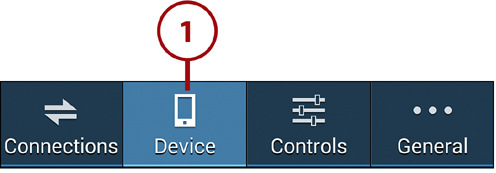
2. Touch to enable or disable Blocking mode.
3. Touch to configure Blocking mode.

4. Touch to enable or disable blocking all incoming calls while in Blocking mode.
5. Touch to enable or disable blocking all notifications while in Blocking mode.
6. Touch to enable or disable blocking all alarms and timers while in Blocking mode.
7. Touch to enable or disable blocking the LED indicator while in Blocking mode.
8. Touch to set the Blocking mode to Always. Uncheck to set it for a specific period.
9. Set the period of time when Blocking mode is automatically enabled and disabled.
10. Touch to configure which contact’s calls will get through when Blocking mode is enabled.
11. Touch to save your changes and return to the previous screen.

S Pen
The S Pen Settings screen enables you to configure how your S Pen behaves and even makes it possible for your Galaxy Note 3 to alert you if you leave your S Pen on the desk and walk away.
1. Touch Controls.
2. Touch S Pen.

3. Touch to disable S Pen detection, which saves the battery. S Pen detection enables your Galaxy Note 3 to detect when you remove the S Pen from its holder.
4. Touch to enable or disable S Pen Keeper that alerts you if you set down your S Pen and walk away without it.
5. Touch to enable or disable showing a pointer on the screen marking where the S Pen is hovering.
6. Touch to enable or disable a feature that opens Popup Note, which is a mini version of S Note, when you detach your S Pen. This can be useful for writing quick notes.
7. Touch to change what app is launched when you detach the S Pen. You can choose None, Action Memo, or Air Command. Learn more about Air Command in the Prologue.
8. Touch to change the sound that is played when you detach your S Pen.
9. Touch to save your changes and return to the previous screen.

Motion Control
Your Note 3 has a number of Motion Control features that enable you to use hand movements and phone movements to show information and perform certain functions.
1. Touch Controls.
2. Scroll down to Motion Control and touch to configure Motion.
3. Touch to enable or disable Air Gesture, and manage which air gestures are enabled.
4. Touch to enable or disable Air View and manage which Air View options are enabled.

5. Touch to enable or disable Air Command, which enables you to perform additional functions by pressing the button on the S Pen while you hover it over the screen.
6. Touch to enable or disable Motions that allow your Note 3 to do certain things when you pick it up, tilt it, pan it, or turn it over.
7. Touch to enable or disable Smart Screen and decide which Smart Screen functions are enabled. Smart Screen uses the front sensor to track your eyes and perform certain functions based on where you are looking.
8. Touch to increase touch sensitivity so you can use your Note 3 with gloves on.




